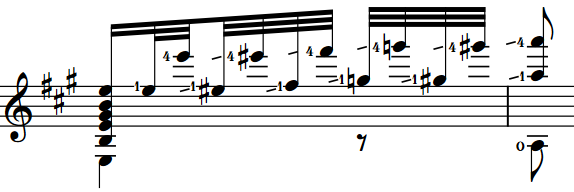Fingering slides
Fingering slides indicate that the performer should slide their finger up/down the neck of the instrument. They are notated as an angled line between fingerings.
The note at the start of a fingering slide is known as a source note. The note at the end of a fingering slide is known as the destination note.

When the source and destination notes are sufficiently close horizontally, fingering slides are shown between the fingerings, joining them directly in their existing positions without moving them. When the source and destination notes are far apart horizontally, fingering slides appear with a fixed length to the left of the destination note. You can change the length of individual fingering slides.
Fingering slides automatically avoid obstructions, such as noteheads, accidentals, and other fingerings.
-
Dorico Pro automatically adjusts the length/angle of fingering slides when you move the fingerings at the start/end.
-
In Dorico Pro, you can only show fingering slides on staves belonging to fretted instruments. You can show string fingering shift indicators on staves belonging to other string instruments.